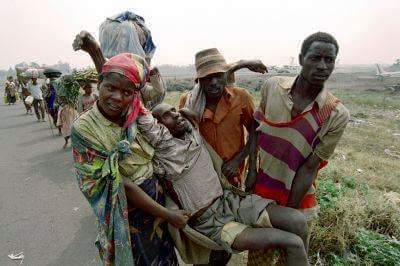In 1996, UNHCR estimated that there were 307,499 refugees spread over the 26 camps in the territories of Walungu, Kabare and Kalehe, commonly known as the “Bukavu camps”. The attacking forces of Alliance of Democratic Forces for the Liberation of Congo (AFDL) and Rwandan Patriotic Army (RPA) advanced towards Bukavu from the South. When they left Nyantende village, the AFDL/APR troops split into two groups. The first group continued in the direction of Bukavu. The second group headed towards Walungu-Centre.
On Saturday 2 November 1996, after the capture of Bukavu, AFDL/APR units attacked the ADI-Kivu, Kashusha and INERA refugee camps in the Kabare territory with heavy weapons, killing thousands of refugees. It is around ten o’clock in the morning when a rain of bombs begins to fall on the three camps of Kashusha, Inera and ADI Kivu. Then RPA soldiers burst into the camp, machine-gunning with automatic weapons, supported by heavy weapons. During the attack, AFDL/APR soldiers fired indiscriminately. Outflanked, FAZ troops from the camp security contingent CZSC (Contingent zaïrois pour la sécurité des camps) fled, followed by some of the refugees.
No one will be able to count the refugees who fell under the bullets of the RPA soldiers during 4 days of the relentless massacre. The save-who-can was catastrophic; no parent could have time to take their child to flee with it, and so far some surviving families are still searching for family members.

A long human tide took the Kavumu-Goma road which runs along Lake Kivu. Another column of refugees headed towards the Kawuzi-Biega Natural Park and trying to make their way towards the town of Kisangani. In this group were about ten nuns from the congregation of the Benebikira sisters as well as a Catholic priest. They were caught two days later by RPF soldiers in the locality of Shabunda. The sisters were raped and then killed; the priest was also tortured and then executed.
“I was part of the flow of people who fled by road to Goma. In passing, the inhabitants of the camps located along the road, those of Idjwi and the local populations came to swell the crowd. Three days later, all this human tide finds itself blocked in Nyabibwe, a small town some two hundred kilometers from Bukavu. We had no way to advance any further as Kagame’s soldiers have taken up positions in Minova and are operating hand in hand with the local Mai Mai fighters who were bought to hunt down and kill Rwandan Hutu refugees. The only solution we had left was to climb the mountains, cross the forests of Masisi and Walikale to try to reach the road that leads to Kisangani.”
In about two hours since the start of the attack, all that remained in the camps were the wounded, sick, old people and children who had lost their way in the stampede. They were regrouped by the Rwandan Tutsi soldiers and massacred the same day.
After systematically looting the camps, RPF soldiers burned the bodies of the victims with gasoline and the ashes loaded into military trucks and thrown into the Rusizi River according to reliable testimonies I have received from the Congolese survivors of Kavumu and Bukavu. According to the same sources, that same day, two young women who were hospitalized in Kavumu maternity hospital were thrown alive with their infants into the toilet of a local trader by the name of Tumbo.
